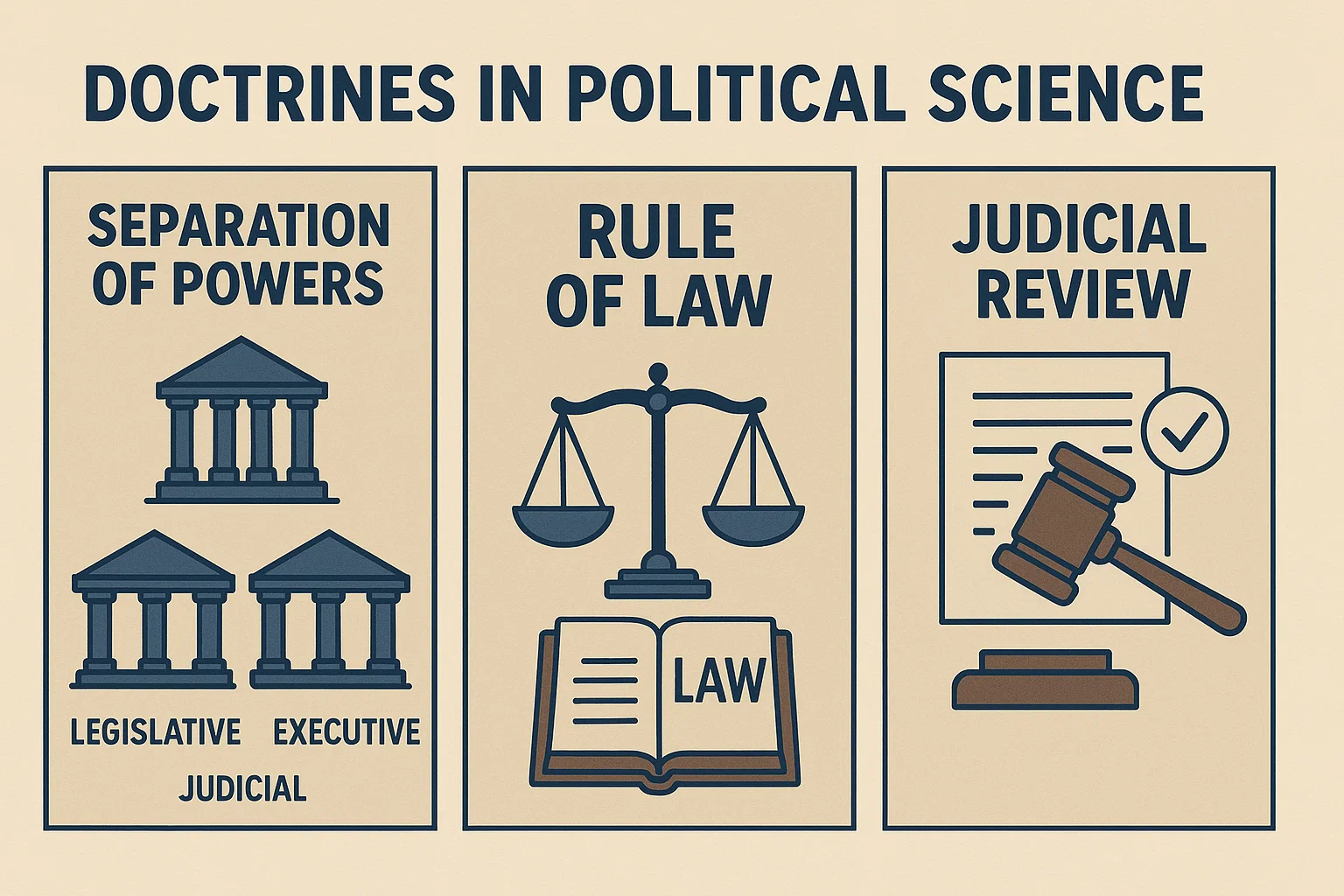Separation of Powers
In the vast world of political science, Separation of powers stands out as a cornerstone doctrine that forms the backbone of most modern democracies. It’s all about ensuring that no single branch of government has too much power. Think of it as a three-part harmony—each part playing its own notes, but together creating a balanced melody of governance.
Montesquieu’s Theory
The doctrine of separation of powers was famously articulated by the 18th-century French political philosopher Baron de Montesquieu in his seminal work The Spirit of the Laws (1748). Montesquieu observed that when legislative, executive, and judicial powers are concentrated in a single authority, it leads to tyranny.
He proposed that the three branches of government should be:
Legislative (makes laws)
Executive (enforces laws)
Judicial (interprets laws)
Montesquieu believed that liberty thrives when these functions are separate and independently exercised. His ideas were inspired by the British constitutional model, though critics argue that he misunderstood the complexity of that system.
Nonetheless, his doctrine became a guiding principle for the development of modern constitutions, particularly influencing the United States Constitution and other liberal democracies.
Application in Modern States
In today’s world, the idea of separation of powers remains relevant, though its implementation varies based on governmental structures and constitutional provisions.
Presidential System (e.g., USA)
In countries like the United States, separation of powers is rigid and institutionalized. The President (Executive) cannot be a member of Congress (Legislature), and judges (Judiciary) serve independently with life tenure in most cases.
Key features:
Clear demarcation of powers
Checks and balances (e.g., veto, judicial review)
Independent appointments and impeachment processes
This rigid model ensures minimal overlap and promotes accountability. However, it can sometimes lead to gridlock, especially when different branches are controlled by opposing political parties.
Parliamentary System (e.g., UK, India)
In contrast, parliamentary systems like those in the UK and India operate on a more flexible version of separation. Here, the Executive (Prime Minister and Cabinet) is derived from the Legislature (Parliament).
Key features:
Overlap between Legislature and Executive
Collective responsibility of the Executive to the Legislature
Judiciary remains independent
While this allows for more efficient law-making, it raises concerns about executive dominance, especially when a single party holds a large majority.
Despite the structural differences, most democracies strive to maintain a balance of power through checks and institutional mechanisms, ensuring that no branch overshadows the others.
Rule of Law
Another foundational doctrine in political science is the rule of law—a principle that says everyone, regardless of status, is subject to the law. It’s what separates a lawful society from arbitrary rule and despotism.
A.V. Dicey’s Theory
The rule of law was famously elaborated by Albert Venn Dicey, a British jurist, in the 19th century. His concept outlined three core principles:
Supremacy of Law: No one can be punished or legally made to suffer except for a breach of the law, established through regular legal procedures.
Equality Before Law: Every individual, regardless of rank or position, is subject to the same law and jurisdiction of ordinary courts.
Primacy of Individual Rights: Rights are not granted by the constitution but arise from judicial decisions protecting individual liberties.
Dicey’s ideas emphasized that law must govern, not the whims of individuals in power. His theory shaped British legal thought and had a lasting influence on common law systems.
Application in India and UK
Indian Constitution and Legal Framework
India, though influenced by Dicey, has adapted the rule of law to suit its constitutional and democratic context. The Preamble, Fundamental Rights, and Directive Principles all reinforce the notion that the government operates under the law.
Key highlights:
Article 14 guarantees equality before the law.
Judicial review under Article 13 and 32 ensures unconstitutional laws are struck down.
Due process and procedural fairness are key tenets in criminal and civil matters.
India’s approach blends constitutional supremacy with social justice, aiming to bridge gaps created by centuries of social hierarchy and economic disparity.
UK Common Law System
The UK, lacking a written constitution, relies on common law, judicial precedents, and parliamentary sovereignty. Despite this, the rule of law remains central.
Key features:
The Magna Carta (1215) laid early foundations for legal accountability.
The Human Rights Act 1998 incorporated European human rights norms.
Independent courts regularly review executive actions for legality.
In both India and the UK, the rule of law continues to act as a guardian of liberty, equality, and justice, though the mechanisms may differ.
Judicial Review
Among the most powerful tools in a constitutional democracy, judicial review gives courts the authority to review laws and executive actions to ensure they align with the Constitution. It is the judiciary’s way of holding the other two branches in check, safeguarding citizens’ rights, and maintaining constitutional supremacy.
Scope and Limitations
The scope of judicial review can vary significantly across legal systems, depending on the constitutional framework and judicial activism prevalent in the country.
In India, judicial review is deeply rooted in the Constitution:
Article 13 invalidates laws inconsistent with Fundamental Rights.
Article 32 empowers the Supreme Court to enforce these rights.
Articles 226 and 227 give High Courts similar powers.
This means both Central and State laws can be examined, along with executive actions, ordinances, and constitutional amendments.
But judicial review also has its limitations:
Courts cannot rewrite laws; they can only interpret or nullify them.
They rely on cases being brought before them—there’s no proactive power.
Overreliance may cause tension with elected bodies, especially when judgments are seen as intrusions into policymaking.
Constitutional vs. Legislative Review
There’s a fine line between reviewing a law’s constitutional validity and questioning its legislative wisdom. The former is allowed; the latter is generally avoided. Courts focus on:
Whether the law violates fundamental rights
If proper procedure was followed during enactment
Whether it breaches constitutional provisions
Judicial restraint is often advocated to avoid encroaching on the domain of the Legislature, although this line can blur during times of judicial activism.
Examples from Indian Judiciary
India has witnessed numerous landmark judgments where judicial review has protected democratic values and civil liberties. Let’s dive into two of the most critical cases.
Kesavananda Bharati Case (1973)
Often called the cornerstone of Indian constitutional law, this case tested the validity of constitutional amendments.
Key outcomes:
The Supreme Court ruled that while Parliament has the power to amend the Constitution, it cannot alter its “basic structure.”
This created the Basic Structure Doctrine, ensuring that features like the rule of law, separation of powers, and judicial independence remain untouched.
This case was a watershed moment, balancing legislative power with constitutional sanctity.
Minerva Mills Case (1980)
This case further clarified the limits of Parliament’s power under the amended Article 368.
Key judgments:
Reinforced the Basic Structure Doctrine
Held that harmony between Fundamental Rights and Directive Principles must be maintained.
Asserted that a limited Constitution is essential to democratic survival.
These examples highlight how judicial review has evolved in India to become a shield for democracy rather than a tool of interference.
Judicial Activism
Closely related to judicial review, judicial activism refers to the judiciary taking an active role in enforcing rights, ensuring social justice, and sometimes filling legislative or executive gaps. It goes beyond merely interpreting laws to shaping policy through legal pronouncements.
While controversial, judicial activism has often been the voice of the voiceless, particularly in countries like India where socio-economic inequalities persist.
Landmark Cases
Over the decades, Indian courts have played a pivotal role in expanding the scope of justice through activism. Let’s explore some key examples:
Vishaka v. State of Rajasthan (1997)
In the absence of specific legislation on sexual harassment at the workplace, the Supreme Court laid down the Vishaka Guidelines, which became the legal standard for protecting women’s rights until Parliament enacted the POSH Act (2013).
This case is a prime example of the judiciary stepping in where the Legislature had been silent.
MC Mehta Environmental Cases
Advocate MC Mehta brought numerous Public Interest Litigations (PILs) before the Supreme Court on environmental issues:
Closure of polluting industries in Delhi
Ganga river pollution control
Adoption of CNG in Delhi’s public transport system
These cases pushed Indian environmental jurisprudence forward and showcased how the judiciary can influence public policy positively.
Criticism and Appreciation
Judicial activism is a double-edged sword. On one hand, it has served justice when other branches have failed. On the other, it raises concerns about judicial overreach.
Judicial Overreach
Critics argue that in some instances, courts cross the line:
Intervening in administrative decisions (e.g., school admissions, exam conduct)
Passing judgments that are difficult to implement
Making laws instead of interpreting them
Such actions may dilute the doctrine of separation of powers, undermining democratic institutions.
Social Justice and Rights Protection
On the flip side, judicial activism has:
Amplified the voice of marginalized communities
Enforced rights that would otherwise remain theoretical
Prompted government action in urgent matters (e.g., food security, pollution, healthcare)
Supporters argue that in a developing democracy like India, judicial activism is not just desirable but necessary—especially when governance structures are slow or ineffective.
Conclusion
The doctrines of Separation of Powers, Rule of Law, Judicial Review, and Judicial Activism are not mere theoretical constructs tucked away in political science textbooks—they are the living, breathing principles that shape how democracies function in the real world. Each one serves as a pillar in maintaining balance, justice, and accountability in governance.
Interplay of Doctrines in Modern Democracies
In practice, these doctrines are deeply intertwined. The separation of powers ensures that no branch of government becomes too powerful. The rule of law ensures that everyone, regardless of position, is subject to the same laws. Judicial review acts as a safeguard when the Legislature or Executive oversteps its bounds. And when necessary, judicial activism steps in to protect rights and deliver justice where political will fails.
Together, these doctrines create a complex but resilient system of governance rooted in accountability, justice, and the Constitution. They empower citizens, restrict arbitrariness, and ensure that democratic ideals are upheld not just in spirit but in action.
Balancing Power and Accountability
However, balance is key. If courts become too interventionist, they risk stepping into the roles of the Legislature or Executive—violating the very separation of powers they’re meant to protect. Similarly, unchecked power in the hands of politicians or bureaucrats can erode the rule of law.
Therefore, constant dialogue between institutions, active citizen participation, and a vigilant civil society are crucial to keeping the system in check. Democracies thrive when their foundational doctrines are respected, interpreted wisely, and adapted to changing times without compromising core values.

